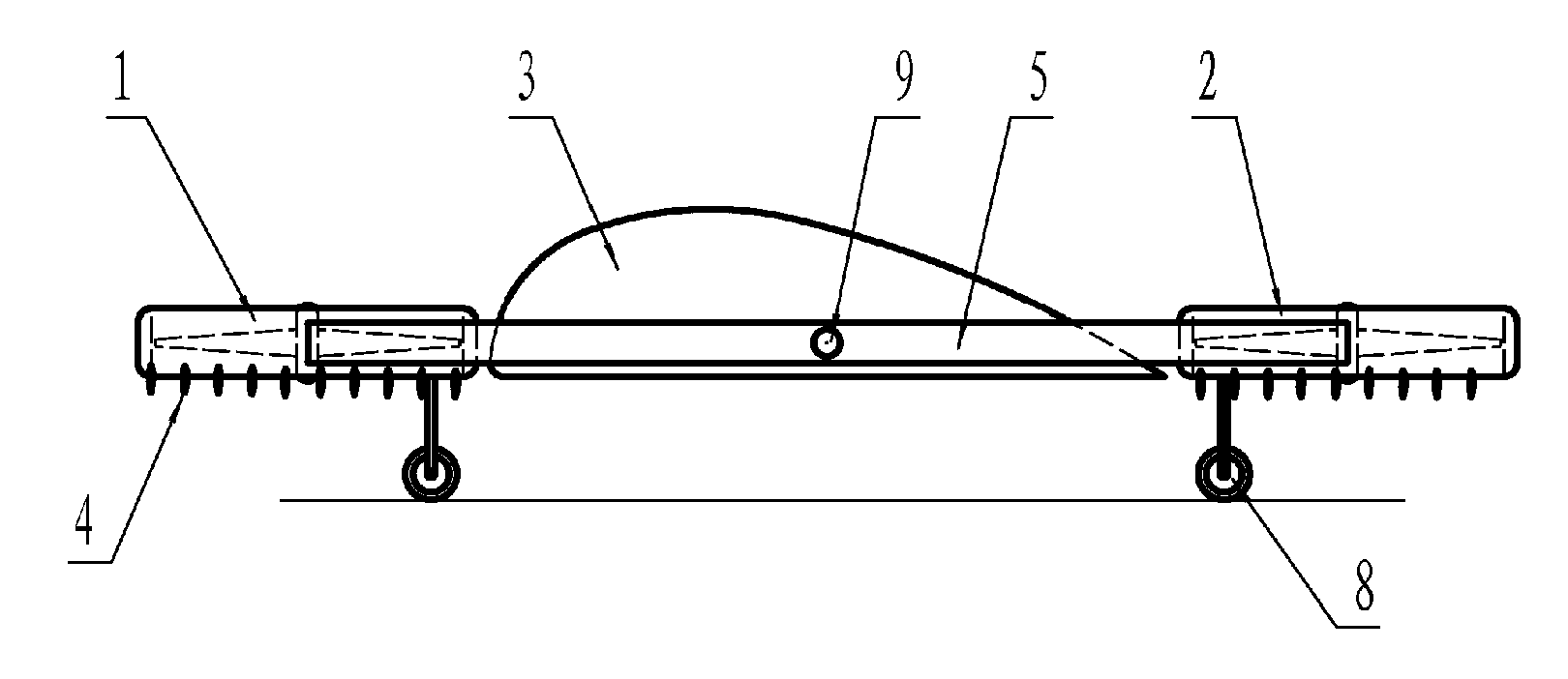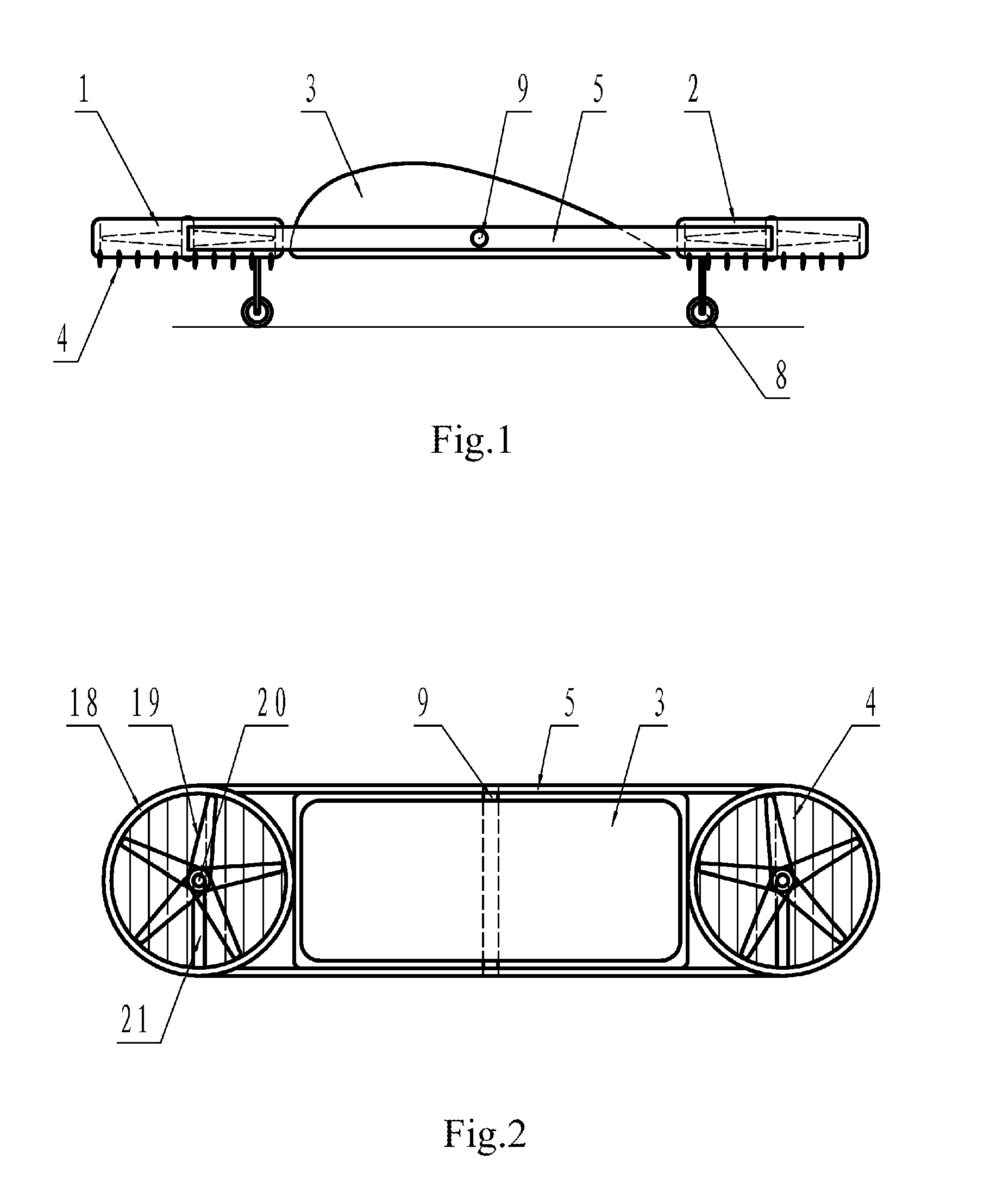Vertical take-off and landing aircraft with tiltrotor power for use on land and in air
a technology of vertical take-off and landing and tilting, which is applied in the direction of vertical landing/take-off aircraft, aircraft navigation control, transportation and packaging, etc., can solve the problems of difficult manufacturing, difficult to observe the conditions ahead of the flying car, and hurting people, so as to achieve safe operation of the aircraft, wide vision, and convenient conversion
- Summary
- Abstract
- Description
- Claims
- Application Information
AI Technical Summary
Benefits of technology
Problems solved by technology
Method used
Image
Examples
example 1
[0043]As shown in FIGS. 1-3, the present aircraft has a body 3, which is designed in accordance with the principles of aerodynamics, and in which an autopilot, a drive device, and a pivot rotation controller (or “tilting mechanism”), etc. can be installed. A first pivot 9 passes transversely through the middle portion of the body 3 with both ends of the first pivot extending out of the body 3. The two ends are connected with transmission brace rods 5 arranged on both sides of the body respectively, and the connecting points are located at the middle point of the transmission brace rods (FIG. 1). This allows keeping front and rear thrusters in balance when the front and the rear thrusters and the body are not subject to external forces. The two transmission brace rods 5 are parallel to each other, and perpendicularly connected to a first pivot 9, thereby constituting an “H”-shaped carrying-sedan structure (FIG. 2).
[0044]Between the front ends of the two transmission brace rods 5 is f...
example 2
[0050]As shown in FIG. 6 and FIG. 7, the aircraft in this example is substantially the same as that in Example 1, except that the first pivot 9 passing transversely through the tail portion of the body 3 and is connected to the rear segments of the transmission brace rods 5. Accordingly, between the body 3 and the transmission brace rods 5 is installed a deflection control mechanism 6 controlling the deflection of the transmission brace rods 5. Via the deflection control mechanism 6, the transmission brace rods 5 may be driven to rotate in the range of 0-90°, so that the front thruster 1 is tilted downwards and the rear thruster 2 is tilted upwards. The deflection control mechanism 6 may comprise a hydraulic cylinder or pneumatic cylinder and other mechanical device.
example 3
[0051]As shown in FIG. 8 and FIG. 9, the aircraft in this example is substantially the same as that in Example 1, except that the aircraft is further provided with two lateral thrusters 16, and the wheels 8 are installed on the bottom of the body 3.
[0052]In FIG. 9, the two ends of the first pivot 9 extend transversely out of the middle portion of the body 3, firstly are connected with the transmission brace rods 5 on the two sides of the body 9, and then each are connected externally to one lateral thruster 16. Thus, the aircraft is provided with ducted fans in the front, rear, left and right directions of the body 3. The two lateral thrusters 16 are tilted by the first pivot 9, and the lateral thrusters 16 on the one hand and the front thruster 1 and the rear thruster 2 connected to the transmission brace rods 5 on the other hand may be tilted synchronously or asynchronously.
[0053]Due to the increased thrust forces, this aircraft can carry increased load and its flight stability an...
PUM
 Login to View More
Login to View More Abstract
Description
Claims
Application Information
 Login to View More
Login to View More - R&D
- Intellectual Property
- Life Sciences
- Materials
- Tech Scout
- Unparalleled Data Quality
- Higher Quality Content
- 60% Fewer Hallucinations
Browse by: Latest US Patents, China's latest patents, Technical Efficacy Thesaurus, Application Domain, Technology Topic, Popular Technical Reports.
© 2025 PatSnap. All rights reserved.Legal|Privacy policy|Modern Slavery Act Transparency Statement|Sitemap|About US| Contact US: help@patsnap.com



